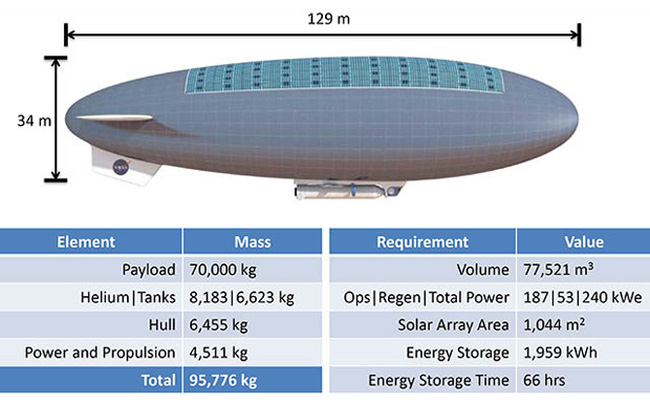Venus, dogged by a myriad of atmospheric elements making the planet far too uninhabitable for man, may somehow be inhabitable for man.
A proposal at US space agency NASA’s systems analysis and concepts directorate (SACD) at Langley Research Center in Hampton, Virginia, for missions to Venus – rather than the far colder Mars to which the vast majority of human colonisation thoughts have been directed – has recently caught the eye.
Starting with some basics, neither Mars nor Venus is in any way near habitable for the average Joe. Mars is freezing cold, with its surface thought to be -55°C on average. Venus, situated far nearer the sun, has an average temperature of 462°C.
However, the thinking at SACD, which is behind NASA’s high altitude operational concept (HAVOC), is that the surface isn’t where we should be looking.

Manned airship specs. Image via Via IEEE/NASA Langley Research Center
Feel the atmosphere
According to a detailed report in IEEE, the temperature at 50km on Venus is around 75°C, not far higher than the Earth’s hottest point. “It averages -63°C on Mars, and while neither extreme would be pleasant for an unprotected human, both are manageable.”
Accepting both temperatures as base points, Venus moves streets ahead of Mars when thinking of a human colony point when you consider both radiation protection and solar power availability (the latter is obvious when considering the proximity to the sun).
The amount of radiation an astronaut would be exposed to in Venus’ atmosphere would be “about the same as if you were in Canada,” says SACD’s Dale Arney, who along with Chris Jones has been investigating a Venus mission. On Mars, the radiation is 40 times that of Earth.
HAVOC’s proposed mission ships are blimps, filled with helium and powered through solar panelling. It is envisaged that it will take several separate missions. The first would be a robotic exploration in a relatively small blimp, then the 30-day crewed mission around Venus’ orbit, before a similar mission within the planet’s atmosphere. Pretty soon, if all went well, a permanent human presence within stationed blimps could be maintained.

Proposed human colony floating 50km above Venus in helium-fuelled, and solar-powered, airships. Image via NASA Langley Research Center
According to SACD, the 30-day mission’s key challenges are “aero capture manoeuvres at Venus and Earth, inserting and inflating the airship at Venus, and protecting the solar panels and structure from the sulphuric acid in the atmosphere.”
“Venus has value as a destination in and of itself for exploration and colonisation,” said Jones. “But it’s also complementary to current Mars plans. There are things that you would need to do for a Mars mission, but we see a little easier path through Venus.”
“If one does see humanity’s future as expanding beyond just Earth, in all likelihood, Venus is probably no worse than the second planet you might go to behind Mars,” said Arney. “Given that Venus’ upper atmosphere is a fairly hospitable destination, we think it can play a role in humanity’s future in space.”